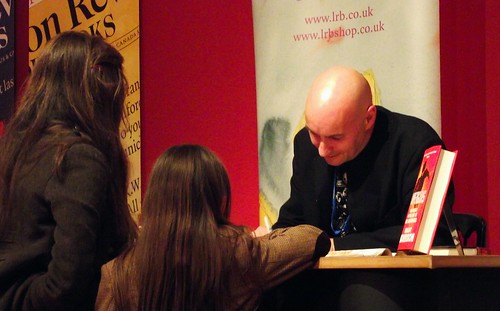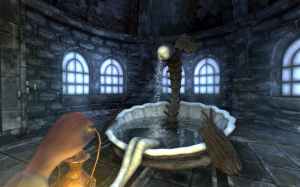
As this is an interpretation/analysis of the film Only God Forgives rather than a review, it goes without saying that it’ll be chock full of SPOILERS….
Based on the sheer spread of reviews and reactions, Nicolas Winding Refn’s Only God Forgives must be the most divisive cinematic release in recent memory. When the film’s end credits rolled at Cannes, half the audience booed and the other half rose to their feet cheering; the breakdown of reviews on aggregator sites like Rotten Tomatoes confirms a thoroughly mixed reaction on the part of critics everywhere. Watching the film, it’s not hard to see why it might confound and frustrate many viewers; nominally a revenge drama about American drug dealers and vigilante cops on the streets of Bangkok, Only God Forgives moves at a glacial pace and has a hazy, dreamlike quality which frequently forces the audience to question whether what they’re seeing is really happening. Add to this its stomach-churning violence and oblique religious symbolism, and you’re left with a film that’s bound to alienate a great many viewers. People who went in expecting a stylistic sequel to Drive (Refn’s previous collaboration with lead actor Ryan Gosling) will have been disappointed, although both films at least share an unflinching approach to violence that appears to be making a deeper philosophical point. Many reviewers have argued that Refn intends Only God Forgives to be interpreted as a religious allegory, while others have suggested that there’s no deeper meaning at all to be found in the film’s beautifully shot but ultimately vacuous scenes. Refn’s own insistence that he merely wanted to make a “western set in the far east” doesn’t really wash when he seems to have put so much effort into packing his scenes with symbolism, although how much of this falls into ‘red herring’ territory is up for debate. So, what is Only God Forgives really about? Ultimately, like most abstract movies, it could be about anything….or nothing. But with this in mind, I tentatively propose the following interpretation:
I believe that a number of critics are right; Only God Forgives is a film about religion, but not necessarily in the way that has been widely suggested. The film is clearly inspired by both Judeo-Christian and Buddhist philosophy, but is less an allegory than a meditation on the nature of evil, and a chronicle of its main character’s spiritual journey.

The devil is made mention of in one of the film’s first lines of dialogue, and this is fitting, since the devil has a major part to play in subsequent story developments. This line does not initiate the allegorical descent into hell which has proved a popular interpretation amongst critics, but rather indicates that what we’re about to see is one of the three representations of the devil (or Satan) explored in Only God Forgives: (1) the personification of evil, (2) the accuser and (3) the arch-manipulator. At the beginning of the film, Billy (Tom Burke), brother of Julian (Ryan Gosling), utters the line, “time to meet the devil” – but who does he go to meet after leaving the boxing club? No-one. He proceeds to start a fight at a local brothel, and then brutally rapes and murders a young prostitute, seemingly for no reason. Whatever Billy meant by his line about the devil in the context of the story, its deeper meaning is clear: in the brutal acts of a cruel man we find the personification of evil; in other words, we have just met the devil. The potential for such evil is in Julian, too; late in the story we’re told of how he murdered his father (in uncertain circumstances), and many times throughout the film Julian is seen regarding his hands (the instruments of this evil) as though they are alien appendages somehow beyond his control. He, too, has a devil in him.

The second face of the devil is represented in the film by Lieutenant Chang (Vithaya Pansringarm), a police officer who has seemingly taken the law into his own hands to deal out Old Testament-style, “eye for an eye” justice on the streets of Bangkok. The Old Testament is actually crucial to understanding Chang’s role in Only God Forgives, as his character represents the true biblical reading of Satan, that of the accuser. Jacques Ellul and other theologians have remarked that the popular conception of Satan as a malevolent, manipulative force of evil is quite at odds with the Old Testament’s portrayal of Satan, where he appears rather as the accuser, the one who points out where guilt lies and where the evil of mankind can be seen. He is not, therefore, the source of evil in the world, but merely the one who points to it. In the film, this function of accusation can be seen when Chang brings a father to see his murdered daughter while her killer (Billy) is still in the room, and then leaves to let him do as he likes. Later, he points out the father’s own sin of letting his daughter walk the streets, and takes the man’s arm in retribution for this negligence. Chang is bringing to light (and then punishing) the evil deeds of men, as he continues to do throughout the film, and thus represents Satan the accuser. Later in the story, as he tortures and kills everyone involved in the attempt on his life, his actions can be read simply as those of a vigilante cop pursuing a vendetta against those who tried to kill him, but can also be seen as the biblical Satan performing his duty of sniffing out evil and bringing punishment to the wicked. In a way, the second devil (the accuser) spends the whole of the film hunting down the first devil (the evil that men do).
What of the third face of the devil, the arch-manipulator? This role is played by Julian and Billy’s mother, Crystal (Kristin Scott Thomas), the terrifying matriarch of their drug smuggling operation who insists upon violent retribution for the death of her son. She commits no violence herself, but threatens, bribes, insults and cajoles others around her until they do her bidding. She thus represents the most popular conception of the devil in Judeo-Christian tradition, that of a manipulative force of evil which bends human beings to its will. It’s fitting then that she’s ultimately killed by Chang – the ‘real’ devil striking down its counterfeit counterpart – but Crystal’s peculiar relationship with Julian is also loaded with meaning. Julian rarely seems to agree with his mother, but is in thrall to her nonetheless, always lighting her cigarettes and taking her insults. In light of her devilish nature, this is hugely significant because of who or what the character of Julian represents in the movie.

We’ve now looked at all three versions of the devil portrayed in Only God Forgives, but one other key element to understanding the film is the character of Julian. The journey he undertakes in the film has a spiritual quality to it, but is also rather meandering. After having strange visions of Chang chopping his arm off, Julian decides not to kill his brother’s murderer, randomly beats up two men in a club, tries to follow Chang and then challenges him to a fight (foolishly, as it turns out), saves Chang’s daughter from his fellow would-be assassin, and finally seems to submit to punishment at the hands (and blade) of Chang – all the while repeatedly regarding his own hands in a strange fashion. What are we to make of such a bizarre array of occurrences? The answer is that, taken together, this series of incidents seems to suggest that Julian’s journey in the film actually symbolises the spiritual progression of mankind as a whole.
This interpretation is not as outlandish as it sounds. Julian (like all humanity) has the capacity for both good and evil, and Only God Forgives chronicles his struggle in determining the right way to live his life, all while interacting with the various guises of the devil. This internal struggle is seen early on in the film, when Julian seemingly forgives his brother’s killer in a move quite out of character for a violent criminal, but soon after randomly assaults the two men he encounters in a club. His pursuit of Chang through Bangkok seems more to be born of a fascination with him (possibly because of his earlier visions), than of a desire to cause him harm. His mother is continually trying to manipulate him and bring out his dark side, first through professions of love, then through insults, and finally through begging. This dark side is represented by Julian’s hands, the hands that killed his own father, on which the camera lingers several times throughout the film. His repeated clenching of his fists hints at an overwhelming destructive drive, and throughout the film Julian is struggling against the temptation to give in to this side of his personality. He doesn’t always succeed, but that early act of forgiveness suggests a possibility of redemption. Despite the film’s title, God is conspicuously absent throughout, but humanity is supposedly made in God’s image and to forgive, said Alexander Pope, is divine. This spark of divinity is therefore within Julian (and indeed humanity).

Refn has been accused of glorifying violence in his films, but I think he actually does quite the opposite. The unflinching depiction of brutal violence in films like Drive and Only God Forgives exposes the audience to its full horror; violence, Refn is saying, is inherently evil. It can perhaps be used in the service of a good cause (one of the morally troublesome things about Drive is that the Driver’s acts of monstrous violence actually help to keep his innocent friends safe), but always represents an act of evil to some degree. With this in mind, there are a couple of ways to interpret the fight scene between Julian and Chang. Julian challenges Chang to a fight, but is this because he thinks he can beat him, or because he thinks it’s a fair way of settling the dispute between Chang and his mother? Julian is soundly beaten in the end, but has he let Chang win, in an attempt to pay the price for his mother’s sins? If so, it doesn’t work; Chang still goes after her. But even if Julian went into the fight intending to win (a lapse back to his violent, dark side), the message here is ultimately the same; evil cannot win out. Violence is not the way. Julian’s ultimate acceptance of this fact and renouncement of evil still doesn’t come until he saves Chang’s daughter from assassination; his mother’s hooks are still in him up to this point. It is of course no accident that this moment of clarity comes just as she dies, almost as if a spell has been lifted.
The battle between good and evil rages within Julian throughout the film, but from the very beginning he knows what he has to do to renounce evil and violence. His early visions of Chang and his repeated staring at his hands signpost the way, but it’s not until the death of his mother and his decision to save Chang’s daughter that he submits himself to the blade of the accuser. How should we interpret this submission? A Christian interpretation (in line with much of the rest of the film) suggests that Julian allowing Chang to take his hands is the ultimate renouncement of violence, a refusal to engage any longer in acts of evil. But there is an additional significance to this scene if we look at it through the prism of Theravada Buddhism, the dominant religion of Thailand (the film’s setting is not, I believe, incidental). Like other forms of Buddhism, Theravada is centrally concerned with the elimination of temptation, and consequently the suffering which comes from that temptation. Julian’s hands, his instruments of destruction, are what draw him towards his dark side; they represent his temptation to do violence. By offering them up to Chang’s blade, he indicates his desire to eliminate that temptation and its associated suffering, and leave his dark side behind (from Chang’s perspective, he identifies the root of Julian’s evil and purges it). Ultimately, the ending is a happy one; despite the machinations of his mother and his own divided nature, Julian chooses good over evil, but it takes a lot of suffering to get there.

This is not a perfect interpretation of Only God Forgives. It takes no account, for instance, of Julian’s strange relationship with Mai, or his gruesome fascination with his dead mother’s womb (although this latter scene could represent humanity’s constant drive to understand where we come from). It also doesn’t speculate too much (as might be necessary) about which people and locations in the movie might only exist within Julian’s mind, or indeed about the extent to which Julian might be somehow mentally impaired (something hinted at by both his mother’s words and the strange way in which he sometimes conducts himself). In the end, there are many aspects of the film which won’t fit comfortably into any model of interpretation, and this is doubtless what Refn intended when he made it. But to think that means the film is meaningless would be a mistake; there is enough potent symbolism in Only God Forgives to support the argument that it’s all about the three faces of the devil and mankind’s spiritual development. Maybe.














